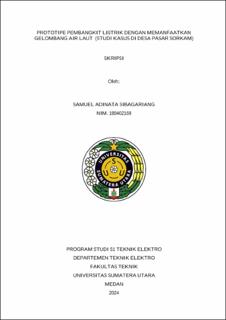| dc.contributor.advisor | HS, Syafruddin | |
| dc.contributor.author | Sibagariang, Samuel Adinata | |
| dc.date.accessioned | 2025-05-22T04:35:47Z | |
| dc.date.available | 2025-05-22T04:35:47Z | |
| dc.date.issued | 2024 | |
| dc.identifier.uri | https://repositori.usu.ac.id/handle/123456789/104021 | |
| dc.description.abstract | Seawater waves are one of the potentially huge sources of alternative energy that will never run out in nature. This energy can be utilized into various things, one of which is a source of energy for propulsion. This research has the aim of utilizing seawater waves as a source of driving energy and will make changes or modifications to the high and low waves into a rotational motion. From the results of this study on the condition of a wave height of 0.95 m, the rotational speed data obtained was 254 RPM, and the power generated reached 24.6 Watt. Based on this research, it can be concluded that the higher the seawater waves that hit the buoy connected to the mechanical transmission system, the greater the district power harvested. | en_US |
| dc.language.iso | id | en_US |
| dc.publisher | Universitas Sumatera Utara | en_US |
| dc.subject | Seawater waves | en_US |
| dc.subject | mechanical transmission system | en_US |
| dc.title | Prototipe Pembangkit Listrik dengan Memanfaatkan Gelombang Air Laut (Studi Kasus di Desa Pasar Sorkam) | en_US |
| dc.title.alternative | Prototype of Electricity Generating Using Sea Water Waves (Case Study in Pasar Sorkam Village) | en_US |
| dc.type | Thesis | en_US |
| dc.identifier.nim | NIM180402169 | |
| dc.identifier.kodeprodi | KODEPRODI20201#Teknik Elektro | |
| dc.description.pages | 58 Pages | en_US |
| dc.description.type | Skripsi Sarjana | en_US |
| dc.subject.sdgs | SDGs 9. Industry Innovation And Infrastructure | en_US |


